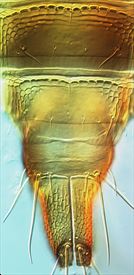Distinguishing features
Female fully winged. Body brown; distal abdominal segments paler medially; antennal segments III–V, tarsi, and hind tibiae yellow; fore wing brown, with 3 irregular transverse pale areas situated sub-basally, medially, and apically. Head transverse; cheeks angulate and strongly protruding; dorsal surface strongly reticulate. Antennae 8-segmented; segments III and IV each with a simple sense cone; segments VI–VIII closely joined. Pronotum without major setae, with surface reticulate except medially. Mesonotum with a longitudinal groove. Legs reticulate; tarsi 1-segmented. Fore wings curved forward apically; first vein fused to costa; major setae not elongate. Tergites strongly sculptured laterally, the antecostal ridge forming a series of pronounced small scallops; tergites V–VII each with a pair of sigmoid setae; tergite IX with lateral setae elongate; tergite X longer than IX, with a complete dorsal split.
Male unknown.
Related species
Only one species is placed in this genus. However, Sigmothrips is closely related to Bhattithrips Mound that comprises four Australian species. The pair of sigmoid setae on tergites, V, VI, and VII is highly distinctive.
Biological data
Collected from seedlings of Coprosma, Geniostoma, Griselinia, Hedycarya, Fuchsia excorticata, and a composite weed. Found on taller plants of Coprosma only in dense native forest with little air movement. Many adults were extracted from native leaf litter, but no pupae were found and these may occur in the soil. Adults and larvae have been collected together at several sites, in association with visible damage to leaves.
Distribution data
Known only from New Zealand, where it occurs widely (Three Kings Islands / ND, AK, CL, WO, BP, GB, TO, HB, WN / SD, NN, BR, SL). Adults have been collected in all months.
Family name
THRIPIDAE, PANCHAETOTHRIPINAE
Species name
Sigmothrips aotearoana Ward
Original name and synonyms
Sigmothrips aotearoana Ward, 1970: 88
References
Martin NA (2017) Hangehange thrips - Sigmothrips aotearoana. http://nzacfactsheets.landcareresearch.co.nz/factsheet/
InterestingInsects/Hangehange-thrips---Sigmothrips-aotearoana.html
Martin NA & Mound LA (2004) Host plants for some New Zealand thrips (Thysanoptera: Terebrantia). New Zealand Entomologist 27: 119–123.
Mound LA & Walker AK (1982) Terebrantia (Insecta: Thysanoptera). Fauna of New Zealand 1: 1–113.



